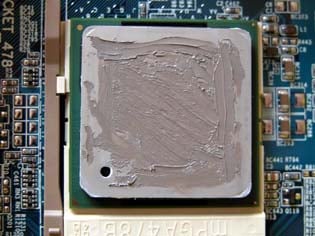
How to optimize the heat transfer between source and dissipator with a conductive paste with a high heat transfer coefficient.
Air is a poor conductor of heat, which means that its thermal conductivity is not enough to dissipate the energy that accumulates in the electromechanical devices. This is the reason why between the heat sink and the source device it is necessary to interpose a plastic film, capable of removing the air between the roughness of the surfaces and of conveying the thermal energy accumulated to the outside. A heat conducting paste is a practical and effective solution. But which are the best features that a good thermal paste needs to have? What chemical composition? How should you behave during prolonged exercise?
In this article we will outline the identikit of the best thermal pastes, analyzing 5 essential points which must not be ignored if you want to obtain an optimal heat transfer without loss of efficiency over time.
Thermalpaste 7001
Thermally conductive paste
Download the technical sheet.pdf
Check the performance of Thermalpaste 7001 thermal paste directly in your project!
Request a free sample
SEND INQUIRY
A thermally conductive paste has two basic functions:
- Improving the transfer of heat ---> high heat transfer coefficient
- Promoting contact and adhesion of the source-dissipator surfaces
The achievement of these two basic qualities needs formulation devices in contrast with each other. Let's see why. A heat conductive paste consists in:
- A base oil, whose function is to make a plastic and solid compound.
- A conductive thickener, to quickly extract and convey heat from the source to the heat sink
- Additives, improvers of thermo-oxidative stability and plastic properties
- Base oil (10-35%)
- Conductive powders (60-85%)
- Additives (1-5%)

Base oil and additives are thermal insulators. However, they are needed to give plasticity, stability and ensuring adhesion of the conductive paste to the substrates. In addition to the thermal efficiency, the compound must not undergo structural changes during thermal cycles - that is to say, it must maintain its properties unaltered for the whole life span of the device where it lives. The graph below compares the thermal conductivities of different materials, and it shows how the base oil has a very low dissipation capacity - only one order of magnitude higher than than of air! It is therefore essential that the conductive powders used in the compound are really performant.
Thermal conductivities (K) compared W / m * ° C

Let's now analyze the 5 basic features of the best thermal paste:
1) It is thixotropic: it does not drip
Depending on the use, the working temperatures of the heat source devices can reach up to 200-250 ° C continuously. Under these conditions it is important that the conductive film does not loose the oily part in order to grant the thermal transfer all over the surface. The conductive powders present in the formulation would actually have no effect on the heat exchange if they were not perfectly dispersed in the oil. To limit the oil separation effect it is necessary to take the following precautions:
- Accurate control of the production process: air removal through degassing during the processing phases
- Specific additives: which allow to limit the release of oil from the paste from the point of application during operation.
2) Its viscosity does not change (or changes little) as the temperature varies
The thickness of the conductive film of the paste decreases with the increase in temperature. This can't be avoided. However, a careful choice of the base oil that makes up the formulation can reduce this phenomenon, and prevent the entry of air bubbles which would decrease the heat transfer coefficient. The graph below shows the kinematic viscosity courses of the various base oils available on the raw material market compared with temperature. It is clear that synthetic oils such as silicones, for example, would be better than mineral oils.
Viscosity curves - Lubricant base oil temperatures compared
Mineral

3) Does not evaporate and does not char
Without proper additivation, the base oil in the paste undergo the following changes during prolonged use at high temperatures:
- evaporation
- primary oxidation
- secondary oxidation
The trigger of the 2nd phase of oxidation also represents the beginning of the carbonization process, that is, the destruction of elementary chemical bonds with loss of the plasticity of the conductive compound.
The minimization of the three phenomena can be favored through suitable measures. This article addresses them in detail.
Below we report the evident effects of evaporation and loss of the conductive film, after prolonged exercise at 130 ° C of two different formulations
- Solution (A) - mineral base oil
- Solution (B) - synthetic base oil
After 5000 hrs, T max - 130 ° C
Zinc oxide thermal paste
Solution (A): high evaporation
Solution (B): reduced evaporation

4) It has a high coefficient of thermal conductivity
Thermal conductivity K is defined as the ratio between the heat flux (Q) transferred in the unit of time through a surface, and the temperature gradient (T1-T2). As seen, the oil present in the paste has a fundamental function in maintaining the plastic matrix whole, but its thermally conductive power is very low. The most important contribution to heat transfer is provided by the solid conductive powders dissolved in the formulation. The thermally conductive pastes can be made with various types of conductive materials, whose compositions and particle sizes greatly affect the dissipation efficiency. Depending on the needs and above all on the quality / price ratio to be obtained, the following elements can be used:
- Diamond
- Silver
- Gold
- Copper
- Zinc oxides
5) It is inert with plastics and rubbers
The presence of plastic or rubber parts in the vicinity of the heat dissipation-source devices focuses attention on the potential non-compatibility phenomena that any contact with the thermoconductive paste could cause, compromising the functionality of the parts over time: sealing rings , rubber gaskets, plastic details. The main effects of these phenomena are addressed in this article.
- Swelling
- Strictions
- Breakages
- Embrittlement
- Changes in mechanical properties: hardness
If you want to learn more about the properties of a thermally conductive silicone paste, please download the technical data sheet below and request a free sample.
Thermalpaste 7001
Thermally conductive paste
Check the performance of Thermalpaste 7001 directly in your project!
Request a free sample
SEND INQUIRY




